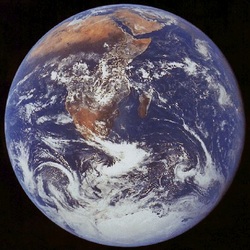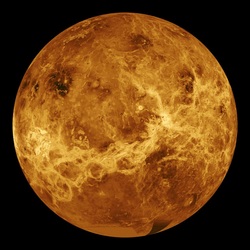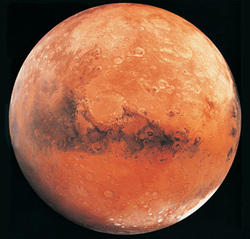Earth

-Terrestrial, rocky
-12,756.2 kilometers in diameter
-150 million km from the sun- 8.5 light minutes away
-On Earth, tectonic plates float on the mantle, where slowly moving convection currents in Earth's mantle move the plates. As plates collide considerable tectonic activity takes place along the plate boundaries. This activity includes earthquake and volcanic activity and is a major mountain building process on Earth.
-Average temperature 18°C to 27°C.
-Earth is highly suitable for and teeming with life. All around the world, the temperature, climate, and other factors are just right to allow for different kinds of life to grow and thrive.
-
-12,756.2 kilometers in diameter
-150 million km from the sun- 8.5 light minutes away
-On Earth, tectonic plates float on the mantle, where slowly moving convection currents in Earth's mantle move the plates. As plates collide considerable tectonic activity takes place along the plate boundaries. This activity includes earthquake and volcanic activity and is a major mountain building process on Earth.
-Average temperature 18°C to 27°C.
-Earth is highly suitable for and teeming with life. All around the world, the temperature, climate, and other factors are just right to allow for different kinds of life to grow and thrive.
-
Venus

-Terrestrial, rocky
-12,100 km in diameter, 95% Earth's diameter
-108 million kilometers from the sun- 6.01 light minutes
-Venus has about 1600 large volcanic features and perhaps hundreds of thousands of smaller volcanic features. Solidified lava flows cover about 80% of its surface. Unlike on Earth, however, the volcanoes on Venus are not concentrated on tectonic plate boundaries. In fact Venus may not have tectonic plates as found on Earth.
-Average temperature 460°C
- The temperatures on Venus are too hot for Earth-style life. However, carbon dioxide, sunlight, and water are found in the clouds of Venus. The cloud pressures are about the same as those on the surface of Earth, and the temperatures in the lower clouds also are quite Earth-like. Although highly acidic, the lower clouds of Venus are the most Earth-like extraterrestrial environment known. No organisms on Earth lead a completely airborne existence, so most scientists dispute the possibility that organisms exist in the clouds of Venus.
-12,100 km in diameter, 95% Earth's diameter
-108 million kilometers from the sun- 6.01 light minutes
-Venus has about 1600 large volcanic features and perhaps hundreds of thousands of smaller volcanic features. Solidified lava flows cover about 80% of its surface. Unlike on Earth, however, the volcanoes on Venus are not concentrated on tectonic plate boundaries. In fact Venus may not have tectonic plates as found on Earth.
-Average temperature 460°C
- The temperatures on Venus are too hot for Earth-style life. However, carbon dioxide, sunlight, and water are found in the clouds of Venus. The cloud pressures are about the same as those on the surface of Earth, and the temperatures in the lower clouds also are quite Earth-like. Although highly acidic, the lower clouds of Venus are the most Earth-like extraterrestrial environment known. No organisms on Earth lead a completely airborne existence, so most scientists dispute the possibility that organisms exist in the clouds of Venus.
Mars

-Terrestrial, rocky
-Mars is a terrestrial planet consisting of minerals containing silicon and oxygen, metals, and other elements that make up rock. Like Earth, Mars has a central core made up of metallic iron and nickel surrounded by a less dense mantle and crust. The planet's distinctive red color is due to the oxidation of iron on its surface.
-6,794 kilometers in diameter, half the diameter of Earth
-227,940,000 kilometers from the sun- 12 minutes and 47 seconds.
-Recent tectonic shifting played a major role in shaping Mars. An area of rumpled land north-west of the giant volcano Olympus Mons contains many ridges and scarps that are likely signs of plate tectonic activity.
-Average temperature -60 °C
-Along with an atmosphere, Mars has weather features that resemble those on Earth. Temperatures on Earth's surface range from a high of about 58°C to a low of about -90°C. Temperatures on Mars are colder, averaging around -60°C. Mars might be described as a frozen desert, but it is possible that its extreme environment could be capable of supporting life.
-Mars is a terrestrial planet consisting of minerals containing silicon and oxygen, metals, and other elements that make up rock. Like Earth, Mars has a central core made up of metallic iron and nickel surrounded by a less dense mantle and crust. The planet's distinctive red color is due to the oxidation of iron on its surface.
-6,794 kilometers in diameter, half the diameter of Earth
-227,940,000 kilometers from the sun- 12 minutes and 47 seconds.
-Recent tectonic shifting played a major role in shaping Mars. An area of rumpled land north-west of the giant volcano Olympus Mons contains many ridges and scarps that are likely signs of plate tectonic activity.
-Average temperature -60 °C
-Along with an atmosphere, Mars has weather features that resemble those on Earth. Temperatures on Earth's surface range from a high of about 58°C to a low of about -90°C. Temperatures on Mars are colder, averaging around -60°C. Mars might be described as a frozen desert, but it is possible that its extreme environment could be capable of supporting life.
